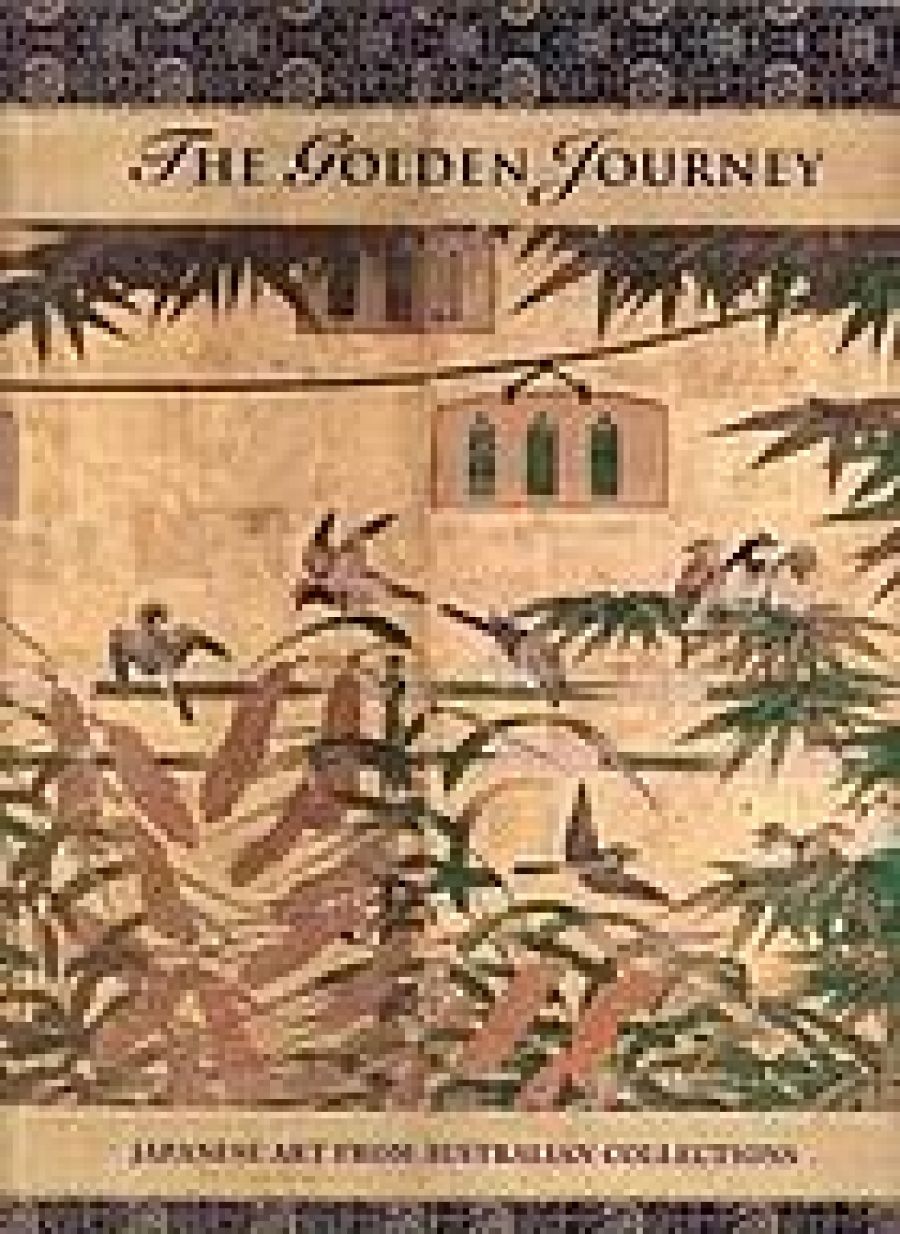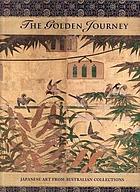
- Free Article: No
- Contents Category: Art
- Review Article: Yes
- Article Title: Japan in Adelaide
- Online Only: No
- Custom Highlight Text:
Australia’s major galleries, with the odd exception, have generally conducted their exhibition programs to show that fanfare for blockbusters is reserved for exhibitions that come from somewhere other than Australia. The die was cast long ago. In the past thirty years, temporary exhibitions have increasingly consumed the lives of public galleries – and blockbusters represent the embodiment of this phenomenon.
- Book 1 Title: The Golden Journey
- Book 1 Subtitle: Japanese art from Australian collections
- Book 1 Biblio: AGSA, $89.95 hb, 348 pp, $69.95 pb
- Book 1 Cover Small (400 x 600):

While the public queue and remain happy with pay per view – like cable television – truly great works, including entire collections, are free to be enjoyed. In the early years, a rough pattern took hold: the arts of Asia were Chinese; antiquities were Egyptian; and French painting from the mid nineteenth century could create inexhaustible attention. Picasso remained a favourite; should we now reasonably assume that Australia might be one of the most Picasso-literate countries in the Western world?
The Art Gallery of South Australia has embarked on an ambitious and long overdue exhibition, The Golden Journey – Japanese Art from Australian Collections. The accompanying book is immensely important. It is an exemplar of exhibition publishing. The scale and depth of the book present Japanese art in Australian collections in a way never previously undertaken. Australians need to know more about Japanese art and also the way it has touched Australian culture – directly and obliquely – since the late nineteenth century.
It is not disparaging to suggest that the broader Australian cultural imagination doesn’t associate the Art Gallery of South Australia with the Arts of Asia. But it should – and now has an astonishing reason to do so – notwithstanding the fact that it has been collecting Asian art for a century, and sections of its collections are always displayed. Until I read the essay on ‘The Early Development of the Japanese Collection of the Art Gallery of South Australia’, I was unaware of the depth of Adelaide’s direct relationship with Japan. The art-historical record tends to emphasise Japonisme as a Melbourne experience – perhaps a Tom Roberts- and Charles Conder-inspired venture – which gave the celebrated 9 by 5 Impression Exhibition of 1889 its special character. Their relationship with Japan occurred through London’s Aesthetic Movement: Whistler in particular, whose greatest devotee was the South Australian born Mortimer Menpes.
The Golden Journey is not one of those all-too-familiar picture books with narrative captions dressed up as new scholarship. It is an elegant and expansive publication with over fifty essays. More than half of these have been written by James Bennett, the exhibition’s organiser and Curator of Asian Art at AGSA. It covers all genres across Japanese art and begins with the subtly idiosyncratic nature of Japanese religious imagery. One recent acquisition is featured early in the piece: Male and Female Shinto Deities (Kamakura Period, thirteenth century). Purchased with a private endowment (the Gallery continues to attract private support for Asian art), it is breathtakingly simple, a personification of poise, calm and introspection.
There are screens, scrolls, woodblock prints and ‘decorative arts’, a necessary catch-all which includes ceramics, a practice regarded by the Japanese as being of the highest artistic order, not a sidekick for something else more important. The essays, however, place everything from deities to lacquer-ware in their proper aesthetic and cultural context. Armour and weapons, too, are included, beauty wrought out of ritualised violence and exhibited as decorative arts. Tsuba (sword guards) have become such a popular collecting genre in recent times that entire auction sales are devoted to them. It is as though we find in these objects beauty transcending violence. But Japan is a culture of perpetual contradictions.
The essays are informative and sharp in their interpretations, which include historical contexts as well as the writer’s response to the objects themselves. This might seem a self-evident prerequisite for art-historical writing, but too often we find that objects of great artistic value become illustrations for the broader description of a culture. But here art represents culture. There is no lumbering obtuseness, but a genuinely fresh feeling for the subject. Bennett has done what so many curators still long to do – become involved with his discipline. Inevitably, books such as this contain a couple of pieces which seem clunky or forced, as though the contributors were learning as they wrote. Overall, however, it is a book of accessible scholarship.
In the context of blockbuster publications, it is worth looking at the style and design – the personality – of this book. Its design seems to offer a respectful nod to the culture it represents. It is thoughtful in the way in which objects are reproduced. There are no follies or gimmicks: the design is grand, but not pompous. Three-dimensional objects are shown in real space – or surrounded by halftones – instead of the art picture book phenomenon of deep-etching objects so that they appear as cultural Frisbees caught in white space (the tea bowls are the only exception to this). For the screens, most pages unfold rather than collapsing into gutters. Details are used to emphasise context, not graphic showmanship.
There are no vainglorious sequences to introduce the book. The Australian International Cultural Foundation is a sponsor; it is part of Art Exhibitions Australia. Over the years, it has produced some of the most nauseatingly vulgar, indeed disingenuous, preambles to its catalogues. The Art Gallery of South Australia has avoided the temptation of fawning: there is an informed foreword by the director, and sponsors get the thanks they deserve – a restrained paragraph for each. But there are no introductions from prime ministers, ministers, ambassadors, premiers or chairmen. Some of these publications have even been accompanied by portrait photographs of those who agreed to have their signed and utterly irrelevant messages introduce exhibitions. To be grateful is one thing – to indulge in an orgy of self-congratulations is another. Such rot might carry some doubtful weight at home, but internationally it is an embarrassment.
Japanese culture avoids ego, and this book offers recognition of this. Here we have a publication that celebrates the arts of Japan in Australia – one that is not only a local triumph but also a book which ought to hold the attention of curators, historians and devotees everywhere.


Comments powered by CComment